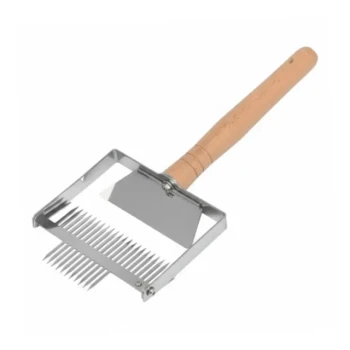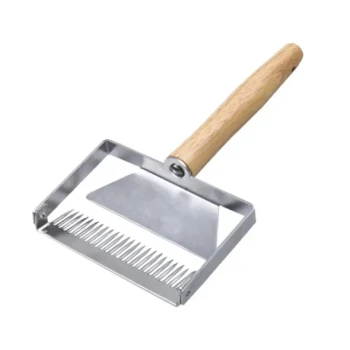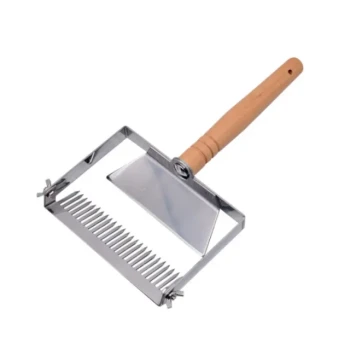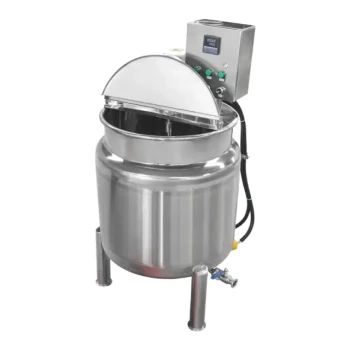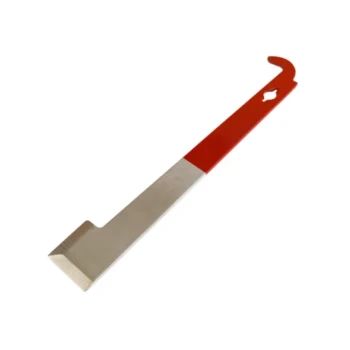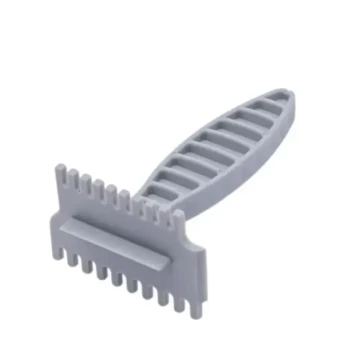The essential equipment for honey extraction includes a tool to uncap the honeycomb, a honey extractor to spin the honey out, a sieve or filter to strain the honey, and food-grade containers for storage. While a basic setup can be quite simple, the specific tools you need depend on the scale of your operation and your budget.
Understanding honey extraction is not about memorizing a list of tools, but about seeing it as a clear, sequential process. Each piece of equipment solves a specific problem in the journey from the wax comb to the final, clean jar of honey.
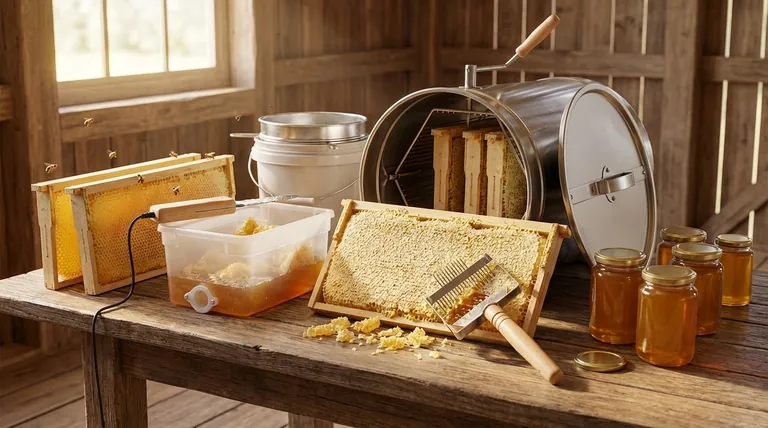
The Core Extraction Workflow: From Comb to Jar
Successfully extracting honey involves a series of steps, each requiring specific tools. This process ensures you get the maximum amount of clean honey while preserving the delicate honeycomb for the bees to reuse.
Step 1: Uncapping the Honeycomb
Before you can extract the honey, you must remove the protective wax cappings that bees build over each cell of honey.
The primary tool for this is an uncapping knife. These can be "cold" knives or, for more efficiency, heated electric knives that slice through the wax with ease.
You will also need an uncapping scratcher or fork. This tool is used to pierce cappings in lower-lying areas of the comb that the knife might miss.
As you slice off the cappings, they fall into an uncapping tank or a simple food-grade bucket. This catches the wax and any dripping honey, which can be strained later.
Step 2: Extracting the Honey
This is the central step where the honey is removed from the comb cells.
The key piece of equipment is the honey extractor. This is a large drum with a basket inside that holds the honey frames.
The extractor works using centrifugal force. As you spin the frames (either by a hand crank or an electric motor), the force slings the liquid honey out of the cells and onto the inner wall of the drum.
The honey then pools at the bottom of the extractor, ready to be drained. This method has the significant advantage of leaving the comb intact for the bees to use again.
Step 3: Straining and Filtering
The raw honey collected in the extractor will contain small bits of beeswax, pollen, and other hive debris.
To produce clear honey, you must strain it. This is typically done using a double sieve, with a coarse mesh on top and a finer mesh below, which fits over a bucket.
Alternatively, you can use cheesecloth or specialized honey filters to achieve the same result. The goal is to remove all solid particles before bottling.
Step 4: Bottling and Storing
Once strained, the honey needs to be transferred to its final containers.
The most convenient tool for this is a bottling bucket. This is a food-grade bucket fitted with a honey gate, which is a special valve at the bottom that allows for clean, controlled filling of jars without drips.
Finally, you will need your honey jars or containers with airtight lids to store your harvest and protect it from moisture and contaminants.
Common Pitfalls and Key Decisions
Choosing your equipment involves balancing cost, efficiency, and the scale of your beekeeping. Investing in the wrong tools can lead to frustration and wasted time.
The Critical Choice: Manual vs. Electric
For both uncapping knives and extractors, you have a choice between manual and electric models. An electric heated knife melts through wax cappings much faster than a cold knife.
Likewise, an electric extractor removes the physical labor of hand-cranking and can process frames much more quickly, which is a major advantage for anyone with more than a couple of hives. The trade-off is a significantly higher initial cost.
The Alternative Method: Honey Pressing
An alternative to a centrifugal extractor is a honey press. This method works by crushing the entire comb and pressing the honey out.
While a press can be effective, it has one major drawback: it completely destroys the honeycomb. Because bees expend a tremendous amount of energy to build wax comb, preserving it with an extractor saves them weeks of work and leads to higher honey production in the long run.
The "Nice-to-Have" vs. The "Need-to-Have"
Many beginner kits include items that aren't strictly for extraction, such as bee brushes or hive tools. While these are essential for beekeeping in general, they are used to get the frames out of the hive, not to extract the honey itself. Focus first on the four core steps: uncapping, extracting, straining, and bottling.
Making the Right Choice for Your Apiary
Your equipment needs will grow with your apiary. Match your investment to your current needs and future goals.
- If your primary focus is a hobby with 1-3 hives: A manual extractor, a cold uncapping knife and scratcher, and a simple bucket-and-sieve setup are perfectly sufficient and cost-effective.
- If your primary focus is efficiency with 4+ hives: Investing in an electric extractor and a heated uncapping knife will save you a tremendous amount of time and physical effort.
- If your primary focus is maximizing honey yield over time: A centrifugal extractor is the only choice, as it preserves your valuable drawn comb for the bees to refill.
Choosing the right tools from the start allows you to enjoy the rewarding process of harvesting your own pure, raw honey.
Summary Table:
| Equipment | Purpose | Key Consideration |
|---|---|---|
| Uncapping Knife/Scratcher | Removes wax cappings from honeycomb. | Heated knives are faster; cold knives are budget-friendly. |
| Honey Extractor | Spins honey out of frames using centrifugal force. | Manual for small-scale; electric for efficiency with 4+ hives. |
| Strainer/Sieve | Filters out wax and debris from raw honey. | A double sieve is most effective for clear honey. |
| Bottling Bucket with Honey Gate | Allows for clean, controlled filling of jars. | Essential for professional, drip-free bottling. |
Ready to equip your apiary for a successful harvest?
As a trusted wholesale supplier to commercial apiaries and equipment distributors, HONESTBEE provides the durable, high-performance extraction equipment you need to scale your operation. From manual extractors for growing apiaries to commercial-grade electric models that maximize efficiency, we have the right tools for your primary focus.
Let's discuss your needs: Contact our expert team today to find the perfect equipment solution for your beekeeping goals.
Visual Guide
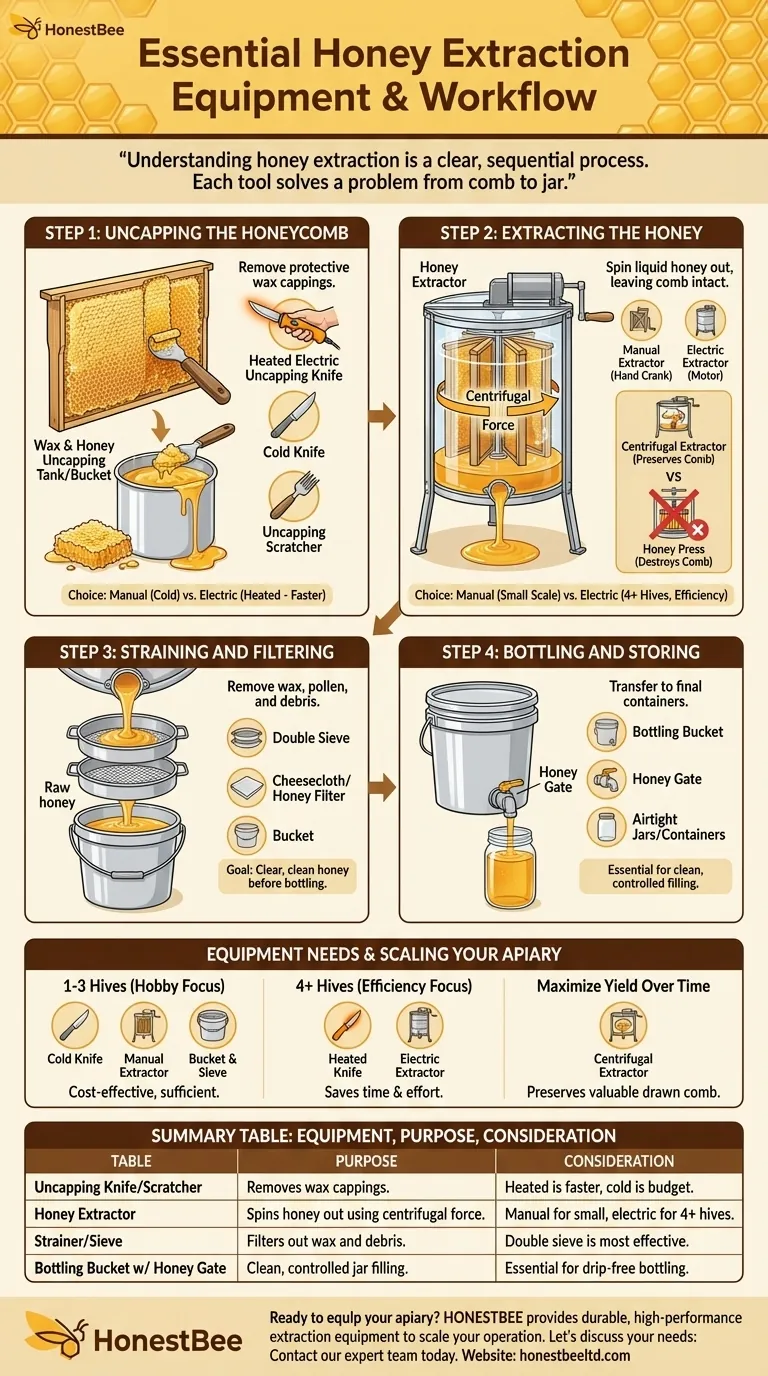
Related Products
- Stainless Steel Double Sided Honey Uncapping Fork with Scraper
- Extra Wide Stainless Steel Honey Uncapping Fork with Scraper Beekeeping Tool
- Wide Adjustable Stainless Steel Honey Uncapping Fork with Scraper
- Stainless Steel Dual Blade Uncapping Plane
- HONESTBEE 3-Frame Manual Acrylic Honey Extractor
People Also Ask
- What tools are available for uncapping honey? A Guide to Choosing the Right Tool for Your Operation
- How does an uncapping fork work, and what are its benefits? Achieve Precision Unsealing for Your Honey Frames
- What is an uncapping knife? Choose the Right Tool for Your Beekeeping Scale
- What makes polyurethane foam environmentally friendly? The Surprising Benefits of a Durable, Inert Material
- What other tools are available for honey uncapping besides knives? Find the Right Tool for Your Apiary's Scale
